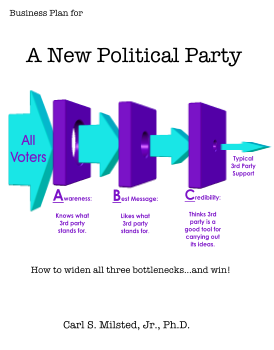Finding the Early Adopters
So, even from the start it is possible for a new party to have two of the bottlenecks substantially wider than for the Libertarian Party (B and D). Awareness is fairly deterministic. Tell people in person about your existence and ideas and they are made aware. Credibility is the tough one, but even here we have a few tricks that none of the other third parties have.
Still, the mathematics of a four-bottleneck stream are brutal. Suppose you reach 10% of the people, half like your message, 10% think you are credible and 10% are willing to help out. Multiply these numbers together and you get 0.05% of the electorate active in your new party.
Obviously, we need to do some targeting at the outset. Once we have a big enough activist base, we can broaden the base and win elections.
That is, we need to target people who have a high likelihood of liking the message, being willing to take a risk on a new party, being indifferent to the choice between the major parties and having a high propensity for activism. Since we have a message that may require some education before acceptance, we might throw in the criterion of willingness to listen to a complex message.
This indicates that from the start we shouldn’t worry about sound bites and quick messages. Web sites, personal contact, white papers, books and possibly CDs should be the way to go at first.
We also want to target local groups of people. It is much more productive to speak before a group of people than one-on-one. There are more listeners per hour of speaker time, and the message gets discussed between the participants. (See Chapters 3 and 5 of Gladwell’s The Tipping Point.) Furthermore, there is more credibility when a group gets the message. If the individual participants like the message they immediately know that they are not alone in liking the message.
Indifference to the D-R choice means a more narrow focus:
�
So within what existing groups can we find a high density of people who fit in the core area? (When I say fit, I mean by propensity. Many who would like to be in this area may be politically elsewhere now because they need education to realize that an upper left agenda can exist.)
Some possibilities:
-
John Birch Society members and related conspiracy buffs.
-
Buchananite conservatives.
-
Ron Paul small-l libertarians (some of).
-
Blue collar individualists (some of).
-
Some academics.
-
Freedom loving students.
-
Non-socialist ACLU types.
-
Individualistic environmentalists.
-
The Religious Left.
-
Jimmy Carter Democrats.
-
“Crunchy” libertarians (as in granola).
-
Some of the hippie Luddites.
-
Some of the New Agers.
-
Inner city minority groups unhappy with the social Democrat agenda.
-
Geolibertarians.
One possibility would be to try to recruit some from all of these groups at once. Doing so in theory gives us the maximum potential for political victory. It also requires more marketing efforts, and has a large potential for acrimony and schism from the start.
I could be wrong, but I think it may be more productive to follow the LP’s marketing consultant’s advice and focus on a subset and then add other groups in. Our criteria for which groups include:
-
Plays well with others.
-
Is attractive to others.
-
Is big enough to have clout somewhere.
-
Includes some largish donors.
-
Has a high propensity for activism.
-
Has roots in community.
The first criterion rules out the conspiracy buffs. The second rules out Buchananites; their borderline racism is extremely unattractive to most others. Unfortunately, these are two groups that already understand the concept of an upper-left agenda. Few of the others do.
Geolibertarians and crunchy libertarians both already get it, but are both very small groups. Since I already have contact with both, awareness is easy and they will be invited. However, I think targeting one or more larger groups is far more important, even if it sacrifices initial support from members of these two groups.
I see three main clusters of initial groups which work well together:
Cluster 1
|
Cluster 2
|
Cluster 3
|
|
Certain academics, individualistic students, freedom loving environmentalists,
hippie Luddites, New Agers, Geolibertarians and crunchy libertarians, ACLU
types
|
The Religious Left, minority members unhappy with the social Democratic
agenda, Jimmy Carter Democrats
|
John Birchers, Buchananites, blue collar individualists, Ron Paul
libertarians
|
There is overlap between these groups.
It may be best to launch three parties initially, one for each cluster, and later merge or work together later. (The Republican Party was the result of a merger.) Cluster 1 seems appropriate for the Pacific coast, Cluster 2 in the Old South. Cluster 3 might be the strongest approach in the rust belt or in the Rockies. But these are speculations; I don’t know these areas well enough to say for certain. The big problem with Cluster 3 is that it is often taken for the Right, so targeting this cluster could lead to a dead end except in very red states.
My own propensity at the moment is to try for the Religious Left and minority groups. The former is a huge group with established activists, roots in the community, and significant donor base. The latter are geographically concentrated in one-party areas. The down side of this targeting is that these groups are harder to reach via the Web, and part of the general populace may be repelled by a religious themed party further down the road. (But keep in mind that both of the major parties frequently resort to religious language. Political decisions are a subset of moral decisions.)
Previous
| 1
| 2
| 3
| 4 | 5
| 6
| 7
| 8
| 9
| 10
| 11
| Next
Copyright 2007, Carl S. Milsted, Jr. All rights reserved.
|







